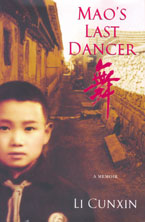A personal account of the upheavals created by Mao's Cultural Revolution by a peasant boy trained to become one of China's cultural emissaries.

GOLDSEA | ASIAN BOOKVIEW | MEMOIRS
Mao's Last Dancer
by Li Cunxin
G.P. Putnam's Sons, New York, 2004, 445 pp, $25.95
 n the day of her marriage, a young girl sits alone in her village home. It is autumn, a beautiful October morning. The country air is cool but fresh.
n the day of her marriage, a young girl sits alone in her village home. It is autumn, a beautiful October morning. The country air is cool but fresh.
The young girl hears happy music approaching her house. She is only eighteen, and she is nervous, frighteened. She knows that many marriage introducers simply take money and tell lies. Some women from her village marry men who don't have all their functional body parts. Those women have to spend the rest of their lives looking after their husbands. Wife beating is common. Divorce is out of the question. Divorced women are humiliated, despised, suffering worse than an animals fate. She knows some women hang themselves instead, and she prays this is not going to be her fate.
[CONTINUED BELOW]
